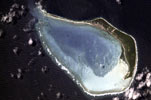Lakshadweep Archipelago
 The Lakshadweep archipelago (still commonly referred to as the Laccadive Islands) consist of a group of atolls,
reefs and submerged banks located in the eastern Arabian Sea. They lie around 220 km off southwestern India's Kerala
Coast and form a Union Territory of India, being the smallest in terms of land area, covering a total of 32 km²,
spread across some 20,000 km² of ocean.
The Lakshadweep archipelago (still commonly referred to as the Laccadive Islands) consist of a group of atolls,
reefs and submerged banks located in the eastern Arabian Sea. They lie around 220 km off southwestern India's Kerala
Coast and form a Union Territory of India, being the smallest in terms of land area, covering a total of 32 km²,
spread across some 20,000 km² of ocean.
The Lakshadweep archipelago consists of 12 atolls, 3 reefs and 5 submerged banks divided in to northern and southern groups. In total there are 36 islands and islets. In the north are the Amindivi Islands: Amini (2.6 km²), Bitra (0.1 km²), Cardamum (3.1 km²), Chelat (1 km²) and Kiltan (1.63 km²). In the south are the Cannanore Islands: Agatti (2.7 km²), Andrott (4.8 km²), Kalpeni (2.5 km²), Kavaratti (3.6 km²), Pitti (1 ha) and Suheli Par (57 ha). Also included as part of the Lakshadweep archipelago is the outlying atoll of Minicoy (4.4 km²), located 175 km to the south, across the Nine Degree Channel, from the Cannanore Islands. Only the islands of Agatti, Amini, Andrott, Bitra, Chetlat, Kadmat, Kalpeni, Kiltan and Minicoy are inhabited.
The Lakshadweep are atoll formations — the oldest such structures to have formed on the 2,000 km long Laccadive-Chagos Ridge — and are part of a long chain of atolls, reefs and banks that includes the Maldives and the Chagos Archipelago to the south. The atolls are generally small with very shallow lagoons, with average depths of between 3 and 5 m, with islands usually being located on their eastern sides. The outer edges of the atolls descend rapidly in to deep water of between 1,500 and 4,000 m depth. Most are orientated northeast to southwest with broad reefs on the west.
Islands are low and flat (reaching 4-6 m) and are composed of coarse sand, coral and shell fragments, uncemented pebbles, shingles, cobbles and boulders. Very little of their original vegetation remains, with most of the land being cultivated under coconut plantation. On Minicoy there is a small stand of Mangrove (Bruguiera parviflora). Uncultivated areas have vegetation types typical of the Indo-Pacific atolls.
The archipelago experiences a monsoon-dominated tropical climate, with dry and wet seasons. The dry season from December to March is influenced by the northeast monsoon and the wet season from April to October being influenced by the southwest monsoon. Annual rainfall varies from around 1,500 mm in the slightly drier north to 1,640 mm in the south. Tropical storms originating from the southern reaches of the Arabian Sea can be bring strong cyclones to the islands during the months of April and May, while in winter months between October and December heavy rains and winds can be brought from storms moving westwards from the Bay of Bengal. There is very little variation in temperature outside the average range of 24°C to 30°C.
